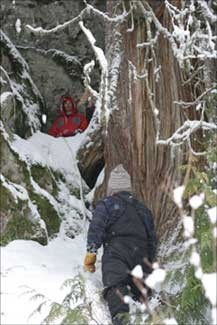2006 is the tenth anniversary of bear education in Whistler schools and the thirteenth year (1994-2006) of bear research. I am pleased with the 500 presentations (600 hours) to 4,500 students at Myrtle Philip and Spring Creek Community Schools since my first nervous bear talk in 1997.
Program
success stemmed from studies of at least 300 bear-life years. Bear talks began
with the mission of teaching local kids about local bears
while stimulating younger “open”
minds with an understanding of how a large carnivore (bears feed as omnivores)
might adapt to co-existing under the umbrella of a human-dominated landscape.
While “safety around bears” was always discussed to achieve clear understanding, it was never the focus of the talks. I did not want to preach the dangers of bears; instead, I aimed for interest in character. After all, bears are fascinating creatures that undergo incredible behavioral and physiological hurdles to successfully complete life cyclic events. And above all, Whistler bears with their “fluid” knowledge of human dynamics have demonstrated that they can live within a human landscape with little to no conflict.
When research began for my field studies in 1994, I set out to establish my own “classroom of bears”, every bear distinctive of their own character, appearance, and role in the population. In a sense, this focal group of bears in their classroom entered the lives of students in the school classroom. Characters from the field — Susie, Sadie, Hazel, Katie, Marisa, Cassie, Jeanie, Alice, Daisy, Brownie, Slim, Slumber, Hank, King Arthur, Crowner, Huffer, Jake, Jack, Kara, Juniper, and Kit-kat — came to life in the school classroom. As bears grew and changed, so did the kids that were learning about them and so evolved their understanding of bears. The success of the program has been measured in several ways but none is more rewarding than a Grade 11 student recalling, in detail, their elementary years learning about neighboring bears.
2006 Bear Outreach
School outreach continues with spring and fall classroom awareness (Squamish also) and Grade 5 field trips, bear life-history displays, bear paw T-shirts, bear skeleton articulation, bear life history newsletter, and development of the Whistler Black Bear Project website. Bear science for the B.C. school curriculum will be presented to Catalyst 2006, B.C. Science Teacher’s Conference this May in Whistler. Articulated bear skeleton and associated research information will be displayed at the conference.
Public outreach continues with the 12 th year of Bear Update columns in Pique Newsmagazine, sixth year of ski area bear viewing, Millennium Place spring and summer presentations (Whistler Museum and Archives Society), and children’s programs with Whistler Children’s Art Festival. A large-scale visitor initiative will be offered at the Fairmont-Chateau that includes 80 presentations reaching about 8,000 visitors to Whistler.
I am grateful to the many organizations, businesses, and individuals who have supported this successful bear education program.
March bear activity
Most den emergence occurs during April with some lone bears emerging earlier in March while mothers with yearlings (1-year cubs) and mothers with newborn cubs (born January 2006) begin emerging mid-April through early May. Sub-adults (1-3 years) and older bears may emerge in March regardless of snow-pack if they were in poor condition last fall. Bears move from den sites (> 700-metres elevation) to low elevation (600-800-metres) skunk cabbage swamps and green-up patches along watercourses, recreation trails, golf courses, and ski trails. Daybeds are constructed throughout riparian old growth, matured timbered ridges, timbered rock outcrops, and dense second growth near sources of water.
While bears are usually not starving when they emerge, if they have learned that early food sources exist at bird feeders and non-bear proof garbage sheds, they will move to these sites to attempt feeding.
High cub forecast means new bears to eat human foods
Sixty-eight per cent (13 of 19) of adult females from ski area and interpretive forest sub-populations were observed in breeding pairs in 2005 (late May-late July). Cub production is forecasted to be high (13-26 cubs) this year because those females gained sufficient weight due to the high huckleberry/blueberry crops last fall.
One of the main opportunities for bears to learn about human foods is through context habituation — the passing of information or experience from mother to offspring. Cubs may learn food-seeking behaviors from mothers during a potential poor berry crop this fall. If they do, they will carry this knowledge of food-reward with them as yearlings. On their own, yearlings will reinforce this information in order to survive the challenges of feeding and competing with older bears.
We can predict shortages in berry crops and bear-proof potential human food sources to weaken or sever the link between bear families and garbage. It takes time and consistency on the part of people, but it does work. If you keep garbage, recycling, and bird feeders away from bears by storing them inside and dumping them frequently at bear-proof compactors you have contributed to the effort of ensuring a healthy population of black bears at Whistler.




